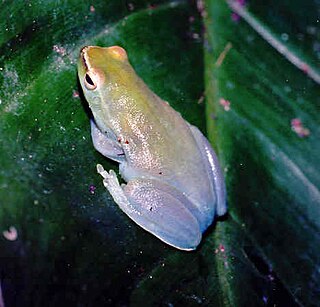
Sphaenorhynchus is a genus of frogs in the family Hylidae. They are also known as lime treefrogs or hatchet-faced treefrogs. They are found in the Amazon and Orinoco River basins of South America, the Guianas, Trinidad, and southern and eastern Brazil. The majority of the species are associated with the Atlantic Forest domain in Brazil.
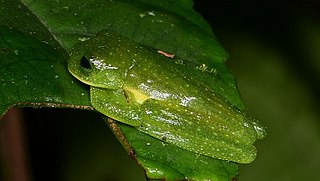
Centrolene ballux is a species of frog in the family Centrolenidae. It is known from a few disjunct localities on the Pacific versant of the Cordillera Occidental in southern Colombia and northern Ecuador. Common names golden-flecked glassfrog and Burrowes' giant glass frog have been coined for it.
"Centrolene" medemi is a species of frog in the family Centrolenidae. The species occurs in the Cordillera Oriental in the Tolima, Caquetá, and Putumayo Departments in Colombia and adjacent Napo in Ecuador. The generic placement of this species within the subfamily Centroleninae is uncertain. The specific name medemi honors Fred Medem, collector of the holotype. Common name Medem giant glass frog has been coined for it.

Nymphargus anomalus is a species of frog in the family Centrolenidae. It is endemic to Ecuador and occurs on the Amazonian slopes of the Ecuadorian Andes in the Napo Province. Common name Napo Cochran frog has been coined for it.
Nymphargus balionotus is a species of frog in the family Centrolenidae. It is found in the Andes of Colombia and Ecuador. Common names Mindo Cochran frog and mottled glassfrog has been coined for it.
Rulyrana flavopunctata is a species of frog in the family Centrolenidae. It is found on the eastern slopes of the Cordillera Oriental in Colombia and on the eastern slopes of the Andes in Ecuador. Common name yellow-spotted Cochran frog has been coined for it.

Sachatamia orejuela is a species of frog in the family Centrolenidae. It is found on the Pacific versant of the Cordillera Occidental in southern Colombia and on the Pacific Andean slopes of northwestern Ecuador. Common name El Tambo Cochran frog has been coined for it.

Cochranella resplendens is a species of frog in the family Centrolenidae. It is found in the upper Amazon Basin in southwestern Colombia, eastern Ecuador, northern Peru, and Bolivia. There are also isolated records from the Cordillera Central in Antioquia, Colombia, and Amapá in northern Brazil. The specific name resplendens is derived from the Latin verb resplendo and hints to the jewel-like appearance of this frog. It is sometimes known as the resplendent Cochran frog or resplendent glassfrog.
Hyalinobatrachium munozorum, also known as Upper Amazon glass frog, is a species of frog in the family Centrolenidae. It is found in the upper Amazon Basin in Ecuador, Colombia, and northern Bolivia; it is presumably to be found in intervening Peru; earlier records from Peru have been assigned to Hyalinobatrachium carlesvilai.
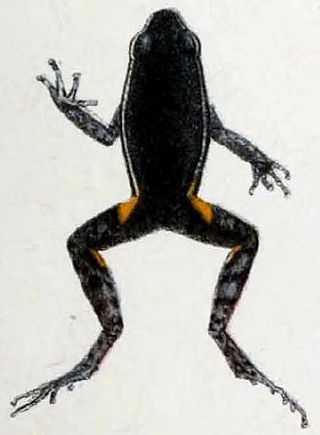
Ameerega hahneli is a species of frog in the family Dendrobatidae. It is found in the Amazonian lowlands of Brazil, Bolivia, Peru, Ecuador, Colombia, Venezuela, Guyana, French Guiana, and Suriname. It is named after Paul Hahnel, the collector of the type series.
Dendropsophus riveroi is a species of frog in the family Hylidae. It is found in the upper Amazon Basin in western Brazil, Bolivia, Peru, Ecuador, and southern Colombia. In Ecuador it has been mixed with the newly described Dendropsophus shiwiarum. The specific name honours Juan A. Rivero.

Sphaenorhynchus is a genus of frogs in the family Hylidae. They are also known as lime treefrogs or hatchet-faced treefrogs. They are found in the Amazon and Orinoco River basins of South America, the Guianas, Trinidad, and southern and eastern Brazil. The majority of the species are associated with the Atlantic Forest domain in Brazil.
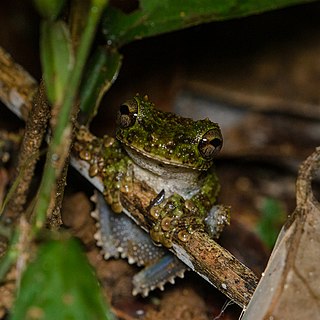
Osteocephalus cabrerai is a species of frog in the family Hylidae. It is found in the Amazon Basin in Brazil (Manaus), northeastern Peru, Ecuador, Colombia, Guyana, and French Guiana, possibly wider. Some earlier records refer to Osteocephalus buckleyi.
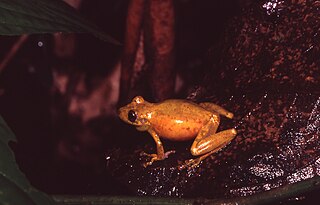
Scinax cruentomma is a species of frog in the family Hylidae. It is found in the upper Amazon Basin of southern Colombia, eastern Ecuador, northeastern and east-central Peru, and western Brazil; its presence is French Guiana is dispted. The specific name cruentomma is derived from the Greek cruentos meaning "bloody" and omma meaning "eye", referring to the red streak in the eye of this frog. This species is also known as the Manaus snouted treefrog.

Scinax ruber is a species of frog in the family Hylidae which is known in English as the red snouted treefrog or red-snouted treefrog, sometimes also Allen's snouted treefrog, the latter referring to the now-synonymized Scinax alleni. This widespread species is found in much of Amazonian and northern coastal South America and into Panama, as well as in some Caribbean islands as introduced populations. It is a complex containing several cryptic species.

Sphaenorhynchus lacteus, the Orinoco lime treefrog or greater hatchet-faced treefrog, is a species of frog in the family Hylidae. It is a widely distributed species found in the Orinoco and Amazon basins in Venezuela, the Guianas, Colombia, Brazil, Ecuador, Peru, and Bolivia. It also occurs in Trinidad and Tobago.
Pristimantis croceoinguinis is a species of frog in the family Strabomantidae. It is found in the lowland Amazon rainforest of southern Colombia, eastern Ecuador, and extreme north-eastern Peru, likely also extending into the adjacent Brazil. The specific name croceoinguinis refers to the color of the inguinal spots of this frog. Common name Santa Cecilia robber frog has been proposed for it.

Diasporus gularis, also known as the Esmeraldas robber frog, is a species of frog in the family Eleutherodactylidae. It is found in western Colombia and northwestern and central Ecuador.

Hamptophryne boliviana, also known as the Bolivian bleating frog or Amazon sheep frog, is a species of frogs in the family Microhylidae. It is found in the northern and western sides of the Amazon basin in Bolivia, Brazil, Colombia, Ecuador, French Guiana, Guyana, Peru, Suriname, and Venezuela. Genetic analysis suggests hidden diversity within the nominal species.
Boana nympha is a species of frog in the family Hylidae. It is endemic to the upper Amazon basin of southern Colombia, eastern Ecuador, and northeastern Peru; its range probably extends into adjacent western Brazil. The specific name nympha alludes to nymphs, beautiful wood- and marsh-dwelling goddesses in Greek mythology. Common name nympha Amazon treefrog has been proposed for it.












